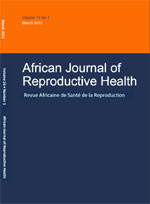
|
African Journal of Reproductive Health
Women's Health and Action Research Centre
ISSN: 1118-4841
Vol. 22, No. 4, 2018, pp. 135-143
|
 Bioline Code: rh18060
Bioline Code: rh18060
Full paper language: English
Document type: Review Article
Document available free of charge
|
|
|
African Journal of Reproductive Health, Vol. 22, No. 4, 2018, pp. 135-143
| en |
The Use of Soluble FMS-like Tyrosine Kinase 1/Placental Growth Factor Ratio in the Clinical Management of Pre-eclampsia
Govender, Nalini; Moodley, Jagidesa & Naicker, Thajasvarie
Abstract
Hypertensive disorders of pregnancy in particular the category preeclampsia (PE), remains a major cause of both maternal and fetal morbidity and mortality. Angiogenic growth factors (PlGF and VEGF) and their tyrosine kinase receptors -1 and 2 (Flt-1 and KDR) are involved in both fetal and placental development. Inadequate placentation and the consequent release of antiangiogenic soluble fms-like tyrosine kinase 1 (sFlt-1) is thus instrumental in the etiology of this disease. sFlt-1 binds to both angiogenic growth factors and neutralizes their effect thereby creating an angiogenic imbalance. This imbalance is frequently reported in women diagnosed with preeclampsia occurring before the clinical manifestation of the disease. The recent prognostic value of the sFlt-1/PlGF ratio has received considerable attention as a risk indicator of preeclampsia development. The aim of this review is to highlight the current advances in the diagnostic utility of the sFlt-1/PlGF ratio with regards to preeclampsia development. (Afr J Reprod Health 2018; 22[4]: 135-143).
Keywords
Preeclampsia; sFlt-1; PlGF; treatment; prediction
|
| |
| fr |
Govender, Nalini; Moodley, Jagidesa & Naicker, Thajasvarie
Résumé
Les troubles hypertensifs de la grossesse, en particulier de la catégorie pré-éclampsie (PE), restent une cause majeure de morbidité et de mortalité maternelles et foetales. Les facteurs de croissance angiogéniques (PlGF et VEGF) et leurs récepteurs tyrosine kinase -1 et 2 (Flt-1 et KDR) sont impliqués dans le développement foetal et placentaire. La placentation inadéquate et la libération consécutive de la tyrosine kinase 1 analogue à la fms soluble anti-angiogénique (sFlt-1) jouent donc un rôle déterminant dans l'étiologie de cette maladie. Le sFlt-1 se lie aux deux facteurs de croissance angiogéniques et neutralise leur effet, créant ainsi un déséquilibre angiogénique. Ce déséquilibre est fréquemment signalé chez les femmes chez lesquelles une pré-éclampsie a été diagnostiquée avant la manifestation clinique de la maladie. La récente valeur pronostique du rapport sFlt-1 / PlGF a fait l‘objet d‘une attention considérable en tant qu‘indicateur de risque de développement de la pré-éclampsie. Le but de cette étude est de mettre en évidence les progrès actuels dans l‘utilité diagnostique de l‘indice de sFlt-1 / PlGF en ce qui concerne le développement de la pré-éclampsie. (Afr J Reprod Health 2018; 22[4]:135-143).
Mots Clés
Pré-éclampsie; sFlt-1; PlGF; traitement; prédiction
|
| |
© Copyright [2018] - African Journal of Reproductive Health
Alternative site location: http://www.ajrh.info
|
|
